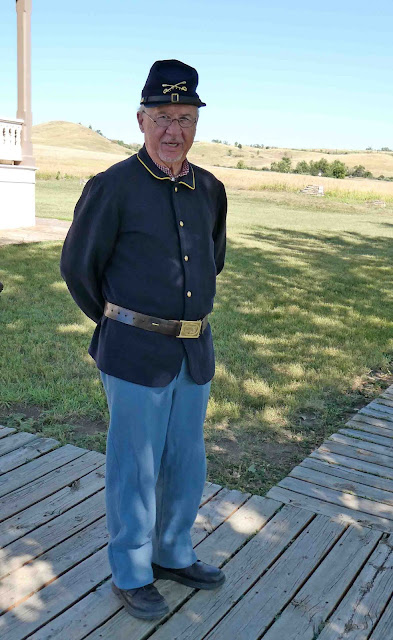As I mentioned in my previous post, there was too much to tell and too many pictures to show for this park, and so I've split it into three posts. You can read Part 1 right here. We drove out toward the park entrance to see what remains of Fort Abraham Lincoln. There was a long board walk from the parking lot through the whole of what I'm about to show you.
As we approached, we came upon this sign. These buildings are reconstructed as authentically as possible.
To our left we noticed the cornerstones that remain from what would have been the officers' barracks.
Just a little farther on, we came upon the home the Custers would have lived in.
Here is the home. Tickets to go inside were $8 each for adults, which seemed a little steep to us. We decided instead to peer in the windows and see what we could see.
Outside a volunteer stood ready to take passholders on a tour and to answer questions. He was dressed in period costume and agreed to allow me to take his picture. He was a very nice man, by the way, and patiently answered all our questions.
The next several photos were taken looking through windows, and so you won't see much, but it will give you a taste.
This next image is looking toward the front door of the house. I stood to the left for this image...
and moving to the right, I could see the stairs.
Around back was a well. This was as close as they got to indoor plumbing. Mike was looking for the bottom.
Looking down, it was fairly deep.
Inside one of the side windows, we could see a wood burning stove...
Most of the windows were covered by curtains, and so that's all I can show you about the Custer House. Looking across the grass we could see the barracks. We walked across the grass to get there since there was a worn path from others doing the same thing.
Inside, it looked a lot like a modern barracks. Notice the blue footlockers at the end of each bed.
Some of them had information about the man who might have used them.
This one was interesting. The "trumpeter" was apparently an important position in the cavalry. It kind of makes sense since they didn't have the radios that allow modern soldiers to communicate. The trumpeter even had his own chevron.
Walking through the barracks, there were two wings connected by this hallway. We imagine this was where they washed up before eating.
The second wing seemed to be a dining hall.
In a separate room, there was a pantry...or they might have referred to it as a larder.
Turning around, this was the kitchen.
Mike was reading this Oath of Allegiance that was lying on the table. Sorry for the blur. The original was blurred too.
There were jackets and hats hanging on hooks, as if the men they belonged to might be returning at any moment.
Here's some information from the park display.
This is how they stored their weapons when not in use.
That's all I have to tell you about this section of the park. I'll finish Part 3 later, and tell you about Fort McKeen and the block houses. That was my favorite part of this visit. I hope you're enjoying the tour so far.





























5 comments:
Inside of me there are two dogs. One is mean and evil and the other is good and they fight each other all the time. When asked which one wins I answer, the one I feed the most. ~ Sitting Bull
It’s very interesting, especially the history of the trumpeter, with his name change and multiple enlistments. Makes you want more details, other than bare bones of the written record. And I like the quote from Sitting Bull, too. Hope Smitty is feeling better. Dot
I haven't left a comment before, but I have been reading your blog for a long time. I love traveling with you and your excellent descriptions and photos of your sight seeing. You have seen some excellent examples of wood cook stoves. I appreciate that I don't have to cook on one, but the advantages of a cook stove over an open fire are immense! I love the ones with the upper warming shelf. I am loving this trip with you.
Oh shoot - if I'd have noticed you were going there, I'd have told you to see if you can find a pitchfork barbeque. I'm serious - it's also called a pitchfork steak fondue. We were treated to one when we visited the Fort. It's a fascinating place!
The Custer house looks as though it would have been considered a showpiece in its time. I can understand charging to visit it though because it's so hard to get funding for upkeep of such places.
It was interesting to read the information about James Quinn and David Cooney because it makes the place seem more real, particularly with the physical descriptions of the men themselves.
Post a Comment